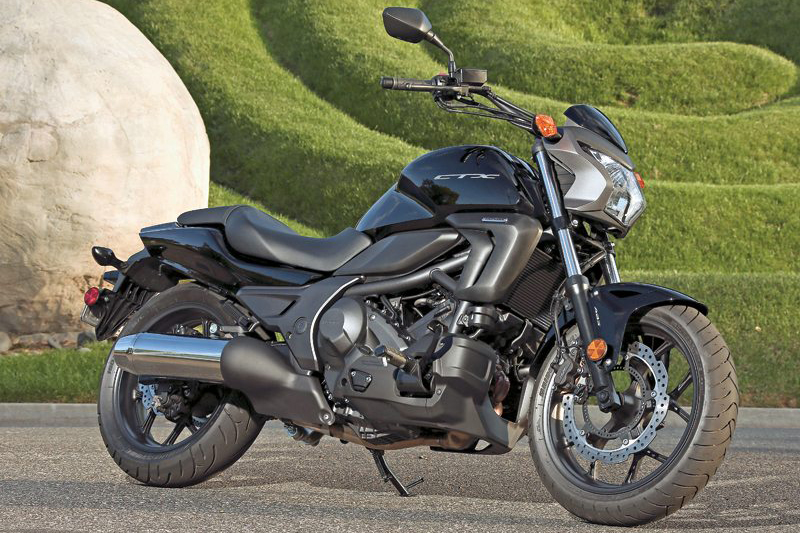2014 Honda CTX700

Road Test Review
If you’re an experienced motorcycle enthusiast, you’ve probably pigeonholed these new Honda CTXs as just beginner’s bikes and are about turn the page. Not so fast. That’s what any number of us old-timers thought when the NC700X/DCT was introduced, too. After testing it thoroughly (Rider, November 2012), we found the NC to be a surprisingly versatile mid-sized adventure bike at a bargain price. Now we have its street-only counterparts in the naked CTX700N and fairing-equipped CTX700, the first of what Honda says will be a series of CTX machines, and calling them just entry-level bikes is an oversimplification as well. They share the NC700X’s efficient liquid-cooled, 670cc parallel twin-cylinder engine, chassis and running gear and also start at $6,999. Like the NC, if you want an automatic dual-clutch transmission (DCT) and ABS, just find 10 more Benjamins.
The idea behind the CTXs is to introduce new riders to motorcycling and bring back former ones, who these days care more about comfort, fuel efficiency and fun than maximum power. They’re also meant to appeal to experienced riders who are seeking some practical everyday transportation for themselves or a mate. At just 28.3 inches, their seats are accessibly low and their cruiserish forward-mounted footpegs and high, wide beach-style handlebars have a relaxed feel. Canting the engine forward 62 degrees helps give them a low center of gravity for better handling, and the available DCT eliminates the potential showstopper of having to shift gears for a new rider, who may never have even done so in a car. Toss in nimble handling, great brakes and low weight, and you have a blend of cruiser and sporty handling that’s all about Comfort, Technology and the riding eXperience—CTX.
For this test, we rode all four models of the CTX at the intro—faired and nekkid, with and without DCT/ABS—but chose to take a CTX700 sans DCT/ABS back to Rider HQ for further flogging. What the added fairing on the CTX700 lacks in looks it makes up in function since, in combination with the shorty windscreen, it creates a large still pocket of air from your waist up to your chin for more comfort on long rides. No DCT/ABS meant we could put the bike on the Jett Tuning rear-wheel dyno (the DCT requires the front wheel to be spinning before it will shift out of second gear), where it made the expected ho-hum 43.6 horsepower peak at 6,100 rpm (redline is at just 6,500 rpm), but impressed us all by churning out 41.9 lb-ft of torque, and a healthy spread of at least 40 lb-ft between 3,000 and 5,600.
Rolling from stoplight-to-stoplight or down the highway, the staggered, counterbalanced power pulses of the engine give it a nice loping feel without excessive vibration, and it makes more-than-adequate power for a solo rider. Add a heavy load or two good-sized riders and brisk passes do require some forethought and a downshift or two. Overall, if you’re not in a huge hurry, for touring solo or slicing through city traffic the CTX is certainly up to the task. And our test bike with manual transmission delivered 61.5 mpg average, very close to Honda’s claim of 64 mpg.
I liked the simplicity and 22-pound weight savings of the CTXs with manual gearboxes, which shift smoothly and cleanly with little effort at the clutch lever. The latest version of Honda’s paddle-shift automatic DCT transmission works really well too, though, especially since you can override it up or down when desired, and it has a “learning function” that can “adapt the automatic shifting actions to variations in operational patterns over time.” Not that I noticed it doing this, but it does sound cool. Not having to shift can be appealing at times, especially when the bike is primarily used for commuting, and you have to get the DCT tranny to get the added safety of anti-lock brakes on this bike.
Though it has a cruiser-like seating position, the CTX offers more cornering clearance than most cruisers, so you can ride it pretty briskly in the corners and canyons before things start to drag. It comes with good Metzeler Roadtec Z8 radials front and rear, which stick well in corners and hard stops. Suspension is firm but compliant on most surfaces, though the short travel in the rear and having all of your weight on the seat means that sharp bumps can deliver a wallop. Fortunately the wide, well-padded seat soaks up some of the jolt and is also great for long rides. Passengers get a large, comfortable seat as well, and on the CTX700 there’s a pair of grabrails for them, too.
All of the bike’s basic features such as the mirrors, headlight, LCD instrumentation and such work just fine (though the horn button is in a weird spot). There’s a small glovebox in the faux gas tank—the smallish 3.3-gallon fuel cell is partially under the seat—and handy bungee hooks for securing a seatbag or gear on the accessory luggage rack. Other functional accessories include locking saddlebags, heated grips and a taller windscreen.
Naked or faired, the first bikes in the CTX series will clearly satisfy the price and performance goals of a lot of riders. The wild card is their styling, which Honda seems to be gambling will appeal to more new riders more than a traditional look. If you like their style, though, these bikes are a safe bet.
